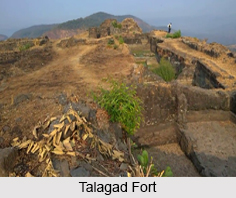 Talagad Fort is located 18 km south of the Roha town of Maharashtra. This fort is at an altitude of 1000feet. This fort is in form of a narrow strip 20mt in width. It is situated on a narrow spur guarded by fortification and served to keep watch on the enemy and the trade route from Maval to the sea ports around. Also this fort was used to keep check on the activity of Sidhhis of Janjira.
Talagad Fort is located 18 km south of the Roha town of Maharashtra. This fort is at an altitude of 1000feet. This fort is in form of a narrow strip 20mt in width. It is situated on a narrow spur guarded by fortification and served to keep watch on the enemy and the trade route from Maval to the sea ports around. Also this fort was used to keep check on the activity of Sidhhis of Janjira.
History of Talagad Fort
In the 16th century, Talagad Fort was under the control of Adilshah of Bijapur. King Shivaji won this fort in 1648. When Afzal Khan attacked the Maratha kingdom in 1659, Siddi seized the Talagad Fort. Later, on hearing the defeat of Afzal Khan, Siddi released the control citing fear from the Maratha warriors. In the Purandar Treaty, King Shivaji kept this fort with himself along with 11 other forts while surrendering the other forts. After the death of Shivaji, Talagad Fort was captured by Siddhi. In 1735, Bajirao Peshwa I captured this fort under Maratha rule. Finally Colonel Prother captured this fort in 1818.
Structure of Talagad Fort
Talagad Fort is in good condition with its bastions and fortification wall still intact. The long fortification around the narrow strip of Machi is in good condition. The main entrance is called "Hanuman Darwaza". There are many rock cut water cisterns on the Balekilla hill. There is an idol of Veer Maruti near the main gate. The fortification is in two layers. On the top most part of the fort there are 7 water tanks and a storage house named "Laxmi Kothar".
Visiting Information of Talagad Fort
There are regular state transport buses and private vehicles which run between Roha, Indapur and Tala. The path from the town goes straight to the main entrance of the fort. The trek route is of 45 minutes. The trek to the fort is simple and safe.



















